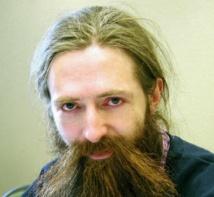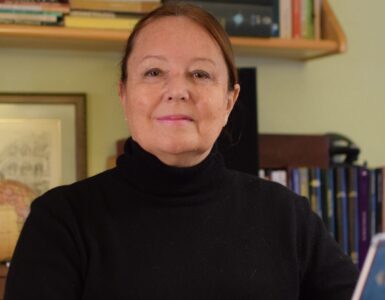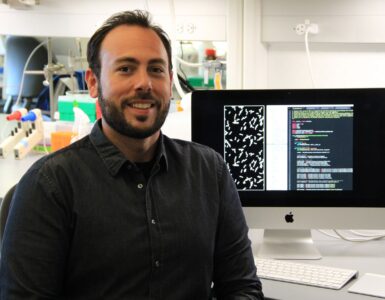
The British gerontologist Aubrey de Gray is committed to dramatically increase the human life. In 2007, he published Ending Aging: The Rejuvenation Breakthroughs that could reverse Human Aging in our lifetime, a book that described the details of the application of biotechnology to rejuvenate the organisms, as well as explained the causes of aging.
This book is published now in Spanish (El fin del envejecimiento. Los avances que podrían revertir el envejecimiento humano durante nuestra vida) by Lola Books. Its presentation in Madrid will be the next March 21 of 2013 in the framework of the celebration of the 25th anniversary of Tendencias21:
Do you think that aging and death are not an inescapable destiny of human being?
What is this thing «aging and death» in the question? It is very instructive that there is so much fatalism about aging that people consider aging to be synonymous with death. Death – from any cause, including causes that are related to how long ago you were born and also causes that are not – is not what I am working to avert. I am working to avert aging, i.e. the ill-health that is currently an inescapable consequence of being alive for a long time. And yes, I think that aging is emphatically NOT an inescapable thing – I am sure that it will eventually be defeated with medicine.
In your book «Ending Aging» you argue that the deterioration of our organism as a result of the passage of time can be braked thanks to certain technologies. What are these?
The technologies that will form the core of comprehensive rejuvenation will include stem cell therapies, gene therapies, and also more traditional interventions such as vaccines and pharmaceuticals. It will be a very complex panel of therapies.
What are the steps or progress made so far by the science that could prolong human life and improve its quality, despite the passage of time?
All the therapies that we need for the control of aging are within reach. In some cases, such as stem cell therapies to replace cells that die and are not automatically replaced by cell division, we are very close – clinical trials are already in progress. In other cases we are still working with mice, or even just cells in a dish, but even there we have a clear way forward to the development of medicine for people.
Do you believe that, in the not too distant future, we could avoid the ballast of the degenerative diseases associated with aging?
Yes I do. I think we have at least a 50% chance of developing truly comprehensive rejuvenation medicine within 25 years, just so long as the early-stage, proof-of-concept research that is going on right now is adequately funded.
What are the «Strategies for Engineered Negligible Senescence» (SENS)?
SENS is a seven-point plan for defeating aging. The various types of damage that accumulate in the body and eventually contribute to ill-health can be classified into just seven categories, for each of which there is a detailed, concrete approach to developing interventions that do not merely slow down its accumulation but actually eliminate what has already accumulated.
At what point is the research on SENS at present?
There is a big spectrum: some aspects of SENS are already in clinical trials, while others are not even being developed in mice yet.
What reception have your proposals and ideas in the scientific field?
Very encouraging. At first, some experts understood and appreciated what I was proposing and others were extremely skeptical, But it only took a few years for most of the skeptics to understand what I was saying and, if not agree wholeheartedly, at least to acknowledge that SENS is a reasonable alternative to other approaches to combat the ill-health of old age.
And what kind or level of financial support have the investigations whose goal lies, in a specific way, in the indefinite prolongation of the human life?
Not nearly enough. SENS Research Foundation has a budget of only $4 million or so per year at present, and if it were $40 million we could certainly accelerate the science by a large factor – probably not 10, but at least three. That’s a hell of a lot of lives that would be saved.
On a planet in wich we suffer from the constant fear of the lack of food resources for a growing population, scientific advances for the indefinite prolongation of human life, paradoxically, couldn’t end up being detrimental to the survival of our own species?
That’s a completely immoral way to think. It’s like saying that it was a mistake to work so hard to postpone cardiovascular diseases because the result has been a rise in the number of people living long enough to get Alzheimer’s disease.. Nobody says that. The fact is, when we have a problem and we create a new problem by solving the first one, the right thing to do is to solve the new problem. In practice, in this case, there is actually very good reason to expect that we won’t even have a new problem in this regard, because natural decline in birth rates combined with reduction in people’s carbon footprint will mean that our environmental impact will not increase anyway.
What do you think it might be the life expectancy of the human being in a hypothetical future, in which all the techniques you speak about were generalizable? Do you think we could count with an indefinite time of life?
It’s absolutely impossible to say how long people would live in a post-aging world, because that depends on changes in mortality risk from causes that don’t have anything to do with aging, and I don’t work on that. All we can say is that people will probably live a lot longer than they do today.
The seven types of aging damage proposed by de Grey
Mutations – in Chromosomes causing cancer due to nuclear mutations/epimutations: These are changes to the nuclear DNA (nDNA), the molecule that contains our genetic information, or to proteins which bind to the nDNA. Certain mutations can lead to cancer, and, according to de Grey, non-cancerous mutations and epimutations do not contribute to aging within a normal lifespan, so cancer is the only endpoint of these types of damage that must be addressed.
Mutations – in Mitochondria: Mitochondria are components in our cells that are important for energy production. They contain their own genetic material, and mutations to their DNA can affect a cell’s ability to function properly. Indirectly, these mutations may accelerate many aspects of aging.
Junk – inside of cells, aka intracellular aggregates: Our cells are constantly breaking down proteins and other molecules that are no longer useful or which can be harmful. Those molecules which can’t be digested simply accumulate as junk inside our cells. Atherosclerosis, macular degeneration and all kinds of neurodegenerative diseases (such as Alzheimer’s disease) are associated with this problem.
Junk – outside of cells, aka extracellular aggregates: Harmful junk protein can also accumulate outside of our cells. The amyloid senile plaque seen in the brains of Alzheimer’s patients is one example.
Cells – too few, aka cellular loss: Some of the cells in our bodies cannot be replaced, or can only be replaced very slowly – more slowly than they die. This decrease in cell number causes the heart to become weaker with age, and it also causes Parkinson’s disease and impairs the immune system.
Cells – too many, aka Cell senescence: This is a phenomenon where the cells are no longer able to divide, but also do not die and let others divide. They may also do other things that they’re not supposed to, like secreting proteins that could be harmful. Cell senescence has been proposed as cause or consequence of type 2 diabetes.[24] Immune senescence is also caused by this.
Extracellular protein crosslinks: Cells are held together by special linking proteins. When too many cross-links form between cells in a tissue, the tissue can lose its elasticity and cause problems including arteriosclerosis and presbyopia.




















Hacer un comentario